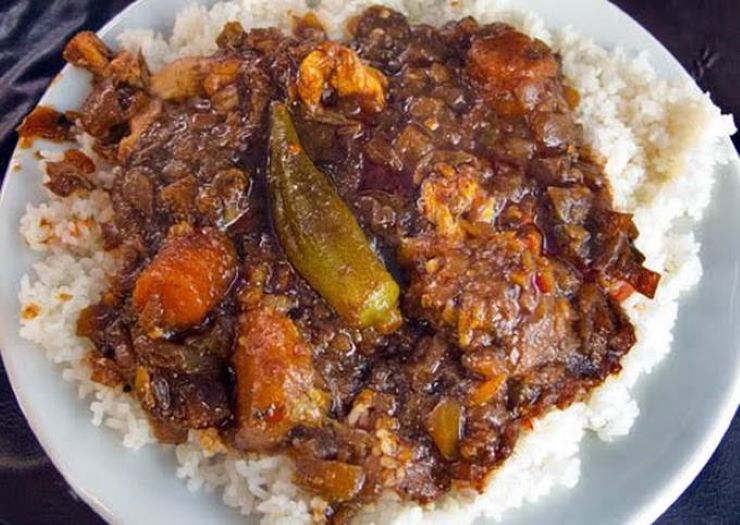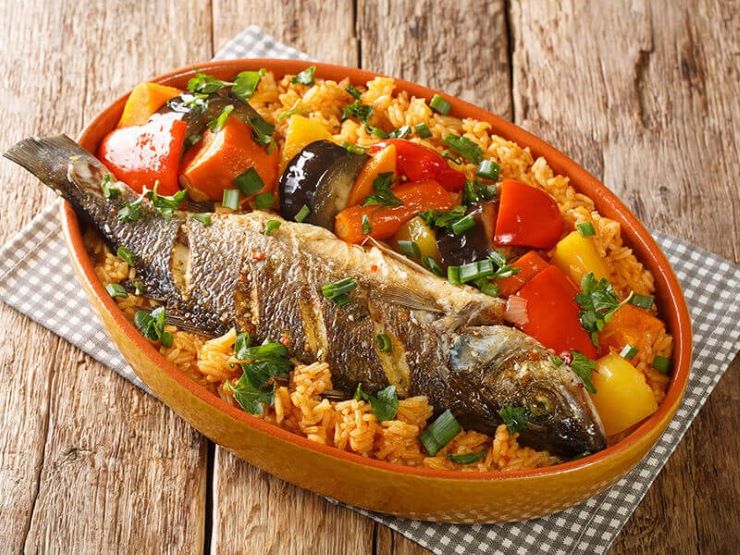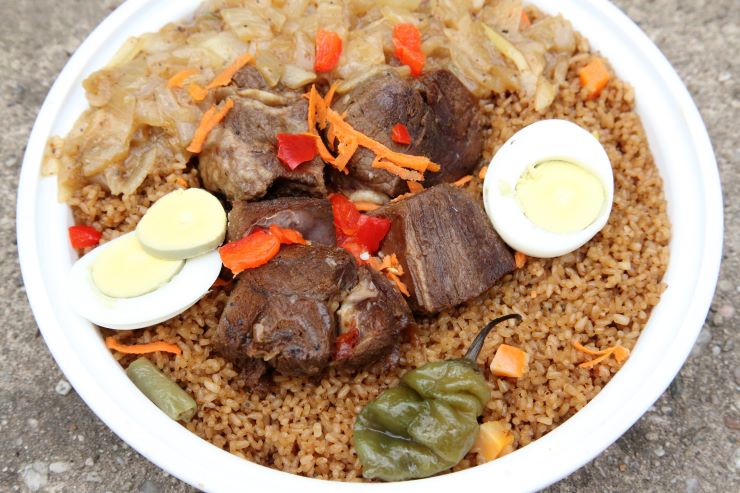With a population of about 17 million people, Senegal is an East African nation rich in culture, art and food of course.
Senegal is one of the most stable nations on the continent thanks to its democratic government and robust institutions.
It is a welcoming, hospitable crossroads of ethnic groups and traditions, all of which contributes to the country’s cultural diversity.
With so much diversity in the country, these Senegalese dishes below are few of the tasty dishes to definitely try out on your next visit to Senegal.
- Soup Kandia: Okra and Palm Oil Sauce
- Thiebou Diola (Seafood Platter with Rice)
- Thiébou Yapp / Ceebu Yapp (The Rice of Meat)
- Mafe (Senegalese Peanut Stew)
- Dibi: Grilled Lamb
- Domoda
- Thiere
- Firire (Senegalese Fried Fish with Sauce)
- Sombi (Senegalese Coconut Rice Pudding)
- Bassi Salte / Bassi-Salté (Millet Couscous with Meat And Veggies)
1. Soup Kandia: Okra and Palm Oil Sauce

This food is one to definitely try out when exploring Senegalese dishes. Okra is known as kandia in Wolof, and kandia soup is a stew made with white rice, palm oil, and okra. Nice components are necessary for a good kandia soup.
Larger okra shouldn’t be used because it’s usually dry. Okra of a medium size is preferable and simpler to prepare.
Don’t overlook the fish, please. It must be a high-quality fish with plenty of flesh and few bones.
The dish includes a peanut butter sauce called souloukhou, to which some diners additionally add a few gombos.
Okra originated in Africa, but it is also a common ingredient in Guyanese, South American, and even Haitian food.
2. Thiebou Diola (Seafood Platter with Rice)

The precise handling of all the materials used in their cuisine is one distinctive characteristic of the Casamance’s Diola people (South Senegal).
The natural ingredients—in this case, seafood—are highlighted strongly in this wonderful delicacy.
Since Senegal was once a French colony, this cuisine also has a French name, which is “C’est Bon,” which translates to “It’s good.”
This dish’s name further indicates that French cuisine has a big impact on it.
3. Thiébou Yapp / Ceebu Yapp (The Rice of Meat)

Both Thiebou Yapp and Ceebu Yapp refer to the same dish; in Wolof, “Yapp” and “Ceeb” stand for rice and beef, respectively.
You can choose the second variant with fish (Thiéboudieune) if you can’t eat lamb or beef, which is often the meat included in Thiébou Yapp.
We advise enjoying this delight for a robust Senegalese lunch because it is filling enough (many Thiebou Yapp stores are open throughout noon) and uses a variety of veggies, including carrot, eggplant, tomatoes, and so on.
4. Mafe (Senegalese Peanut Stew)

In Senegal and Mali, Mafe is a delectable dessert that includes white rice or couscous with a particular peanut butter sauce (simmered with meat, tomato paste, and potatoes).
Typically, lamb or beef is utilized since those meats go well with a flavor that is similar to peanut butter.
The French term for the peanut stew is “Sauce D’arachide,” and there are numerous versions depending on the family.
Although many nations claim to have invented this cuisine, mafe is said to have originated in Senegal and Mali before spreading to other West African nations.
Given that Mafe is so well-liked in Liberia, this cuisine may be the one that embraces it the best.
5. Dibi: Grilled Lamb

The national fast-food dish of Senegal is Dibi, or Senegalese Grilled/Roasted Lamb, which is sliced into small pieces and served with bread, mustard, pepper, and onion.
To provide a fine scent, the meat needs to be well marinated and prepared. The most popular sauce to serve with Dibi is an unique onion sauce called Diaga (contains onions, sliced carrots, tomato paste, and other ingredients).
In Dakar, Dibi is frequently cooked and served by street sellers or tiny restaurants (which are typically referred to as “dibiterie”).
Avoid missing this Senegalese Dibi to learn more about the specialty.
6. Domada

Senegalese cuisine called “domada” is built on a flavorful lemon sauce. For this stew, which cooks in a sauce of tomato paste, onions, vegetables, and lots of lemons, you can use beef, veal, lamb, and fish balls.
A flour and water paste is used to thicken the sauce after it has been cooked.
Also read: 10 Moroccan dishes to try
7. Thiere

A large event like tamkharite calls for millet couscous, a sweet and salty dish with Berber flavors.
Meatballs, potatoes, white beans, dates, and sweet potatoes are all included. It is frequently made with two different kinds of meat, and it is always served with a sauce that is made by boiling meat and vegetables together.
8. Firire (Senegalese Fried Fish with Sauce)

There is no reason why a fried fish meal shouldn’t be the first item in a seafood category.
The presence of the distinctive Senegalese sauce is necessary to provide rich flavors. The variety of fish utilized in this meal is mostly due to the river system and extensive coastline.
The only thing the Senegalese will do after that is cook them until they are crispy and serve them all together with bread, a special onion sauce or compote (to balance the flavors), and a crisp green salad.
9. Sombi (Senegalese Coconut Rice Pudding)

The easiest sweet dish to prepare in Senegal is this one. You might be familiar with it as rice pudding or riz au lait in French.
This dish appears to be prepared differently in almost every nation. Sombi is typically a well-liked kid’s snack. But it’s also an affordable and filling dish.
10. Bassi Salte / Bassi-Salté (Millet Couscous with Meat And Veggies)

Traditional Senegalese food called bassi-salté blends sweet and salty tastes. However, since the sweetness of this meal is entirely natural, you don’t need to worry about the increase in calories (from dates and raisins).
The meal also includes numerous nutrients, including protein from meat (mutton meatballs or diaguas, chicken pieces), fibre, and vitamins, all of which are necessary for lengthy workdays (from carrots, cabbages, and beans).
In addition, Senegalese people consume cassava, a nutritious source of carbohydrates. It will be a wonderful dining experience with a flavour explosion made from basic components.
You must drink fresh milk after eating Bassi-Salté in order to enjoy this delight in the proper Senegalese fashion.
